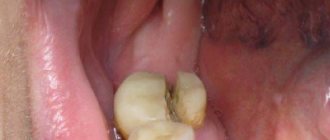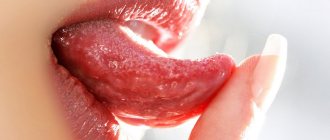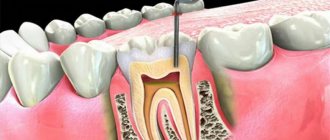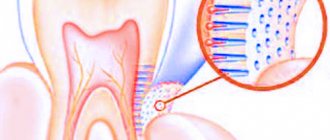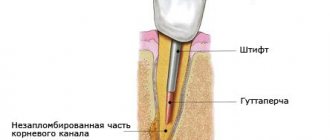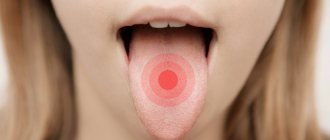It is no secret that calcium is necessary for the formation of bone and dental tissue. In this regard, a completely logical question arises: is it possible to consume additional calcium to strengthen teeth? Dentists unanimously state that during the formation of teeth (and this is during childhood), this macronutrient is extremely necessary, but in adults calcium will not be able to improve their condition. To strengthen tooth enamel, special dental procedures are recommended for adults. In St. Petersburg they are carried out by specialists from Nurimed dentistry. You can make an appointment with a doctor by calling.
Can a dead tooth hurt?
Before answering this question, let’s find out what the concept of “dead tooth” means? This is the common name for a tooth in which, for medical reasons, the pulp has been removed - loose fibrous tissue penetrated by nerve endings, blood and lymphatic vessels. We are talking about depulpation (removal of the pulp) in case of inflammation for various reasons: due to advanced caries, fistulas, cysts, etc.
Calling a pulpless tooth “dead” is not entirely correct. It is indeed separated from the circulatory system and the nervous system, but is still a component of the dentofacial apparatus, where each element affects the condition of the others.
Pain in a tooth with a removed nerve most often means that other parts of the system are involved in the pathological process, “transmitting” unpleasant sensations to the tissues associated with this tooth. Thus, a false impression is created that the pulpless tooth hurts.
Properties of calcium-containing preparations
The main property of a calcium-based substance is considered to be antibacterial. Most dental diseases are associated with bacterial growth. As you know, an acidic environment is ideal for this. But the alkaline environment does not allow infections to exist and multiply. Calcium solutions promote its formation, so most bacteria die immediately, while some require more time to be destroyed.
Since calcium hydroxide powder is diluted in saline solution, the resulting reaction exhibits antiseptic properties. By combining with an aqueous liquid, hydroxyl ions are released, which have an antibacterial effect.
Why does a dead tooth hurt when pressed?
Pain in a tooth without a nerve when biting or pressing can be due to various reasons, and is not necessarily explained by pathology. In the first days after depulpation, discomfort when pressing occurs as a reaction to the procedure itself.
It should be understood that nerve removal and preparation for filling is a microsurgical operation that is impossible without tissue injury. First, the dentist drills out the tooth cavity, then, using special tools - an apex locator and needles of various tapers - penetrates the root and extracts the nerve. Then anti-inflammatory and antibacterial drugs are placed into the cleaned channels.
Post-filling pain
If a filled tooth with a removed nerve hurts for some time, this may be normal, as it can be explained by objective reasons.
- In preparation for a filling, slight damage to the healthy tissue involved in the process may occur. Most often, this is the cause of pain in a dead tooth when pressed. Pains of this origin are called post-filling; they are moderate in nature and, as a rule, disappear after a few days. To relieve discomfort, the doctor usually prescribes painkillers.
- Unpleasant sensations may arise due to the characteristics of the filling material, which expands slightly when entering the root canals and creates pressure on the apex. These pains are temporary and disappear without a trace after a few days.
Intense pain in the tooth under the filling, its sharp increase a few days after the filling and the absence of a tendency to subside after one or two weeks are no longer the norm. This indicates the presence of complications and requires an urgent visit to the dentist's office.
Poorly performed treatment
The cause of pain in a treated tooth due to mechanical action (pressure, biting) may be errors made during endodontic treatment.
- Perforation of the tooth root.
Improper treatment can result in the filling paste extending beyond the root apex into the jawbone tissue. Inflammation under the tooth develops around the foreign body, causing first bursting and then throbbing pain. - Incomplete closure of root canals.
If the length of the canal is incorrectly assessed after filling, part of the cavity remains unfilled, infection develops in the voids, and as a result, when tapped, a tooth without a nerve hurts. - Incomplete depulpation.
If a tooth without a nerve hurts when pressed, this may indicate that the pulp was removed poorly and living tissue remains in the canals. - Poor saliva evacuation.
As a result, pathogenic microorganisms can enter the canal cavity along with the remaining saliva, which leads to tissue infection and pain. - A fragment of a tool in the canal.
Very thin needles used to examine tooth root canals sometimes break and some remain inside, serving as a source of pain and infection. - Specific root structure.
The condition for successful treatment is a completely sealed root system. Some branches, due to the non-standard structure of the apex, are not visible even on an x-ray, and then the dentist is not immune from making a mistake. - The filling is too high.
The ligaments that support the tooth experience increased stress, stretch, and discomfort and pain appear. - Poor quality removal of tissues affected by caries
, which are a source of pathogenic microflora and cause pain in the tooth under the filling.
Pain and swelling of the gums with quality treatment can also be caused by an allergy to a certain type of filling material. In such a situation, the dentist prescribes antihistamines and analgesics.
Cyst
If the nerve has been removed a long time ago—a year or more—and suddenly begins to hurt, the cause may be a root apex cyst. This disease occurs mainly in those teeth that have been subjected to depulpation and treatment. And since the pulp is removed during infection, the likelihood of a cyst subsequently forming is very high.
Inflammation of the trigeminal nerve
A situation where a filled tooth without a nerve hurts when biting or pressing can be caused by trigeminal neuritis. There is no mistake by the dentist here: inflammation can be caused by the treatment process itself. The pain can be constant, paroxysmal, throbbing. In this case, it is not the tooth that needs to be treated, so a neurologist deals with this problem.
Removing the filling material beyond the root apex
If, after treatment of pulpitis, the tooth hurts when pressed, perhaps we are talking about the removal of the filling material beyond the root of the tooth, into the adjacent tissues. The intensity of the sensation depends on how much material has gone beyond the apex of the root. Despite the fact that today a doctor has ample opportunities to control the accuracy of canal filling, as well as the use of high-quality materials, this can happen. It is worth noting that X-ray monitoring of treatment is intended to prevent the development of such a consequence - after the filling is completed, an image should be taken in which, in the event of a re-filling, the doctor will be able to notice excess material and choose the tactics for further action. Re-filling or removal of filling material beyond the root apex in itself does not pose a particular threat.
The exit of the filling material beyond the root apex can cause long-term pain immediately after the anesthetic wears off and persists for a long time - up to several months. This is a natural reaction of tissues to foreign material. Removal of material may be due to the following reasons:
- difficulties in determining the length of channels;
- incorrect selection of a pin from materials for the canal;
- lack of apical stop, etc.
However, this is not the only possible treatment difficulty that provokes pain.
Pain under the crown when pressing
If after dentures there is pain under the crown of a dead tooth when biting, there may be several reasons. The tooth begins to hurt due to mechanical stress in the near future after prosthetics in the following situations:
- poor-quality filling, which was already mentioned earlier;
- due to incorrectly chosen shape or size of the crown, poor fit to the tooth;
- The fixation of the prosthesis is impaired due to an insufficient amount of cement: this allows food to get under the crown and the development of infection.
If pain does not occur immediately, but some time after installation of the prosthesis, this may be due to the following factors:
- violation of the tightness of the filling, crown;
- improper care of dentures and poor oral hygiene, which contributes to tissue infection and inflammation;
- the expiration date of the prosthesis (usually about 5 years).
Another reason for rapid tooth destruction under the crown, resulting in pain, is treatment with potent drugs for severe diseases, chemotherapy, and radiation exposure.
Attention! Unpleasant sensations without acute pain immediately after prosthetics are accompanied by the process of getting used to the crown. This goes away within two to three days after completion of the procedure. If the pain does not go away within the specified time, but rather intensifies, you need to urgently go to the doctor.
We correct other people's mistakes. Dental retreatment with a 10% discount
Moscow
What not to do?
If, after treatment, a tooth hurts when pressed or without mechanical action, you should under no circumstances resort to folk remedies such as heating, hot compresses, heating pads - if there is an inflammatory process, this can greatly worsen the condition. In case of allergic reactions, heat will also increase swelling.
It is also not recommended to use folk remedies for rinsing, which can cause a burn to the mucous membrane - iodine, tinctures of alcohol or vodka, liquids with the juice of “scorching” plants, etc. Even if there is no gum damage, such measures can worsen the situation.
It is also not worth taking various painkillers uncontrollably - firstly, you need to see a doctor in any case, and the effect of analgesics will not allow you to fully evaluate the clinical picture. Secondly, it can be dangerous to health.
It is important to visit a doctor at the first opportunity and perform all the necessary procedures to eliminate unpleasant consequences and improve the condition.
What symptoms should you see a doctor for?
What to do if a tooth with a removed root hurts under the filling when pressed? During the first few days, do not panic and observe the nature and intensity of the pain. Pain during the week after filling may be a normal reaction of the body to surgical procedures. In what cases do you need to urgently contact the clinic?
- If within 5-7 days the pain does not go away, intensifies, changes its character to acute, pulsating;
- swelling of the gums appears;
- there is an increase in body temperature.
In such situations, you need to urgently see a dentist so as not to worsen the situation.
One of the root canals was not processed
This is one of the rarest complications, since before starting endodontic treatment the doctor will definitely prescribe an x-ray diagnosis. It allows you to reliably determine the number of channels and evaluate their structure. But there are cases of abnormal location of root canals or their extremely small sizes, which makes them unnoticed in the image.
This leads to the following situation: the doctor removes the pulp in each canal, but one remains unattended - the inflamed pulp continues to hurt, and pathogenic bacteria continue to multiply. Such pain is difficult to confuse with other complications - the patient simply does not receive relief after treatment, and the pain characteristic of pulpitis itself remains. The sensations are pulsating in nature, the pain intensifies when eating, exposure to temperature on the tooth, and becomes unbearable at night.
The same symptoms can be observed with incomplete removal of the pulp in the diagnosed canal. In both cases, other symptoms may be observed:
- headache, sensations “radiate” to the ear, temple - depending on the specific tooth;
- increased body temperature;
- symptoms of general malaise.
Most complications are related to the complexity of the canal structure, and the following is no exception.
What complications may arise?
Pain in a dead tooth necessarily indicates the presence of some pathology that needs to be eliminated in a timely manner. Infection can lead to serious consequences:
- complete destruction and death of the tooth;
- chronic gum inflammation;
- development of periodontitis, gingivitis;
- the appearance of cysts.
In addition, failure to seek medical help in a timely manner can lead to the development of systemic infections that spread from the periosteum through the bloodstream throughout the body!
Characteristics of the substance
Calcium hydroxide is an inorganic type compound that is produced in powder form.
The pharmaceutical industry produces dental materials based on calcium hydroxide of various types. Their main difference is in the amount of chemical compound contained in the composition. Pure calcium powder is considered one of the most effective. Among the many different chemicals that are used in dental medicine, hydroxide-based materials
Formula and structure of the calcium hydroxide molecule
calcium is the most commonly used. This is due to the unique properties of the substance.
Calcium hydroxide has an alkaline reaction on tissue, as a result of which pathogens that cause destruction of dental canal tissue are destroyed.
In most cases, such materials are used for temporary filling of canals, with the aim of destroying organic tissue under the influence of an alkaline environment.
The result is observed 10-14 days after the temporary filling is installed. During this time, the reaction between the inorganic powder diluted in saline solution and the root tissue allows not only to destroy pathogenic bacteria, but also to disinfect all areas that are inaccessible to mechanical cleaning.
How to relieve pain at home
With moderate syndrome, you can cope with pain using traditional recipes.
- Rinsing with a soda-salt solution will help alleviate the condition; decoctions of medicinal plants: oak root, sage, chamomile, calendula.
- A paste of garlic and onion or a piece of propolis is applied to the diseased tooth.
- The submandibular area on the sore side is massaged for one and a half minutes.
For disinfection, rinsing with the antiseptics chlorhexidine and miramistin is recommended. In order not to endure severe pain while visiting the dentist, you can take medical anti-inflammatory and painkillers: aspirin, analgin, Ketanov, Nurofen; treat the problem area with Dentcos and Kamistad gels.
Important! You should not heat the affected area (this will increase inflammation), or use painkillers for a long time without a doctor’s prescription. All of the above measures will help temporarily relieve pain, but will not stop the process.
The future of calcium hydroxide
In modern dental literature there is a lot of discussion on the use of drugs based on calcium hydroxide. It is believed that the substance is not without its shortcomings, being increasingly criticized.
Today in endodontics, complete preparation of canals and their cleaning are valued in one visit to the dentist, without the need for repeated visits. In the last century, great hopes were placed on copper-calcium hydroxide, since the substance provided excellent antimicrobial action. But the experience of its use in modern clinics cannot be based only on this factor.
The emergence of new research methods and the development of effective methods of tooth root irrigation pose the challenge of rethinking the need to use calcium for temporary filling. But don't underestimate him! In many clinical cases, filling a tooth with calcium can still prolong its health and preserve your smile.
Is it possible to cure a tooth on your own?
Remember: it is impossible to cure a tooth on your own, without the help of a specialist!
All means - medications, folk recipes - have only a temporary, disinfecting and alleviating effect. To get rid of pain, you need to make a correct diagnosis and eliminate the cause, and this can only be done by a dentist in a specialized medical institution using modern diagnostic and treatment technologies. Recommendations for self-treatment of a tooth under a filling can lead to the development of complications even faster.
Allergy
This complication of pulpitis treatment is easier to differentiate - an allergic reaction is often accompanied by tissue swelling. If it is a consequence of material moving outside the root canal, there may be swelling of the gums around the treated tooth. In some cases, it spreads to other areas - cheek, lip, depending on the specific tooth.
When pressure is applied, the pain becomes stronger, it is difficult to relieve with painkillers, and over time it only intensifies.
Treatment of a dead tooth in dentistry
The treatment method for pain in a tooth with a removed nerve depends on the reasons that caused this condition. The dentist will conduct an examination and, if necessary, prescribe an x-ray examination.
- If the cause is unsatisfactory treatment, the filling material is removed, preparation is carried out again, and the canals are inspected with medications placed in them. Then, when the condition returns to normal, the tooth is refilled.
- If the roots are curved, it may be necessary to remove the part that prevents the canals from being cleaned and sealed.
- The cyst or granuloma must be surgically removed along with the pathologically changed tissues around it.
- If there is inflammation of the gums, complex treatment is prescribed. This includes professional teeth cleaning with stone removal, placing medications in periodontal pockets, and taking systemic medications.
- If indicated, physiotherapy procedures are prescribed that have a therapeutic effect on hard tissues.
Remember: by delaying a visit to the dentist, hoping that the pain will go away on its own, you increase the likelihood of serious complications, the treatment of which will be lengthy and possibly expensive.
The use of calcium in the treatment of dental canals
Today, dentistry uses many options for dental treatment. Filling root canals with calcium is considered common.
For this purpose, copper-calcium hydroxide is used, which is introduced with a specialized device - a channel filler. The consistency of the substance is like a paste. By filling the canal, it blocks the entry of bacteria and other infections into it. To fill the root voids more and as densely as possible, a small amount of electricity is often used on the tooth.
This technique is therapeutic and antibacterial in nature, but it is not final. The tooth, with channels filled with calcium, is reliably sealed and remains under its influence for the time specified by the doctor. Then the drug is washed out, an air-alcohol jet is used to dry the resulting cavity, after which a permanent filling occurs. Filling a tooth with calcium, like any dental procedure, is carried out according to appropriate indications. These include:
- chronic apical periodontitis;
- any forms of periodontitis;
- cyst and granuloma of the dental root;
- bone resorption;
- other root canal destruction.
Calcium-based preparations are used by dentists after surgical operations to remove nerve endings. They can also be used before the implantation procedure.
Prevention
You should not think that a tooth with a removed nerve, deprived of blood supply, will relieve you of dental problems - you have already seen this. On the contrary, such teeth are problematic and therefore require more careful care. They are susceptible to any dental diseases - perhaps, except for pulpitis.
- The main means of prevention is thorough oral hygiene 2 times a day using a brush, dental floss, and mouthwash.
- A balanced diet containing enough vitamins and minerals will help keep your teeth longer.
- Regular visits to the dentist - at least once every 3 months - will make it possible to recognize the problem at the initial stage.
And remember: the best prevention of toothache is not to let the tooth need to be depulped, because the likelihood of subsequent complications is very high.
Author: Elena Kopylova Dentist-endodontist. Work experience more than 12 years.
The information is for reference only. Before treatment, consultation with a doctor is necessary.
Medicines and nutritional supplements with calcium to strengthen teeth
Dentists recommend eating a piece of hard cheese with tea after meals. Although calcium will not enter the tooth enamel, it will provoke salivation. The secreted saliva promotes the self-cleaning of tooth enamel. In addition, cheese neutralizes the acids contained in salivary fluid, which in turn helps preserve tooth enamel.
If you can no longer get calcium from food, what can an adult do? Are there methods that work to strengthen tooth enamel? And here the answer is comforting: such methods exist, and some of them can be used at home.
Using toothpastes with fluoride and calcium allows you to perform superficial enamel remineralization at home. The frequency of use of such pastes is prescribed by the dentist.
To achieve faster and more sustainable results over time, you can perform this procedure in a dental office. The essence of the method is to saturate the tooth enamel with minerals. Typically, calcium phosphate and fluorine are used for such purposes. The procedure helps preserve the aesthetics of a smile, and is also used in the complex treatment of tooth sensitivity and a number of other dental problems.

